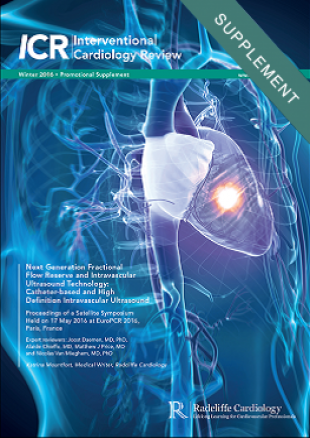Next Generation Fractional Flow Reserve and Intravascular Ultrasound Technology: Catheter-based and High Definition Intravascular Ultrasound
Fractional flow reserve (FFR) assesses the reduction in flow resulting from a coronary artery stenosis. Intravascular ultrasound (IVUS) imaging provides a picture from within a coronary artery showing the vessel wall, plaque and lumen in precise detail. Both are essential tools in the evaluation of the physiological significance and proper treatment of coronary stenosis in the catheterisation laboratory. However, as increasingly complex lesions are being treated, there is a need for improved technologies.
A satellite symposium, sponsored by ACIST® Medical Systems, was held on 17 May 2016 at EuroPCR 2016, Paris, France. The symposium had the following aims:
- To understand the value of FFR-guided percutaneous intervention (PCI).
- To discuss the clinical relevance and benefits of microcatheter-based FFR technology.
- To learn how a new microcatheter-based FFR device and high definition (HDi) IVUS, which improves image quality compared with traditional IVUS systems, can optimise the quality of pre- and post-stent assessments.
The session was chaired by Dr Nicolas Van Mieghem of Rotterdam and Dr Marie-Claude Morice of Massy, Paris. The former began by outlining the regulatory guidelines on the use of FFR. The use of FFR is recommended in US guidelines to assess angiographic intermediate coronary lesions (50–70 % diameter stenosis) and can be useful for guiding revascularisation decisions in patients with stable ischaemic heart disease (Class IIa recommendation, level of evidence A).1 In European guidelines, FFR is recommended for detection of ischaemia-related lesions when objective evidence of vessel-related ischaemia is not available (Class I, level of evidence A).2 It is clear from these guidelines that FFR is a valuable tool in interventional cardiology.
The use of FFR is increasing worldwide, and with this growing demand comes the need for new technologies to improve speed, accuracy and ease of use. The ACIST RXi™ Rapid Exchange FFR system, which features the Navvus® microcatheter, allows FFR assessment after crossing the lesion with any 0.014" guidewire of choice.3 The symposium also introduced the high definition 60 MHz IVUS catheter, which is notable for its superior pullback speed and spatial resolution, affecting image quality and procedural time.
Summary and Take Home notes
Dr Morice ended by summarising the key learning points of the session. Microcatheter-based FFR technology has the potential to simplify PCI procedures as well as allow the use of a workhorse coronary wire to facilitate both complex and routine FFR assessments. It can locate lesion position with microcatheter pullback, leaving the workhorse wire in place. It can also perform post-stent FFR measurements. This session also introduced the first 60 MHz IVUS system, which significantly improves IVUS imaging.
A growing body of clinical evidence is available to support the use of FFR- and IVUS-guided PCI. Ongoing microcatheter-based FFR studies will increase the evidence for the use of resting metrics and contrast media to reduce the need for adenosine. In addition, the utility of post-stent FFR is being investigated. Finally, ongoing studies will reinforce the clinical and procedural benefits of microcatheter-based FFR.
Written by: Katrina Mountfort
Reviewers: Joost Daemen, Alaide Chieffo, Matthew J Price, Nicolas M Van Mieghem
Citation: Interventional Cardiology Review 2016;11(2 Suppl 1):1–8.
DOI: https://doi.org/10.15420/icr.2016:11:2:SUP1








